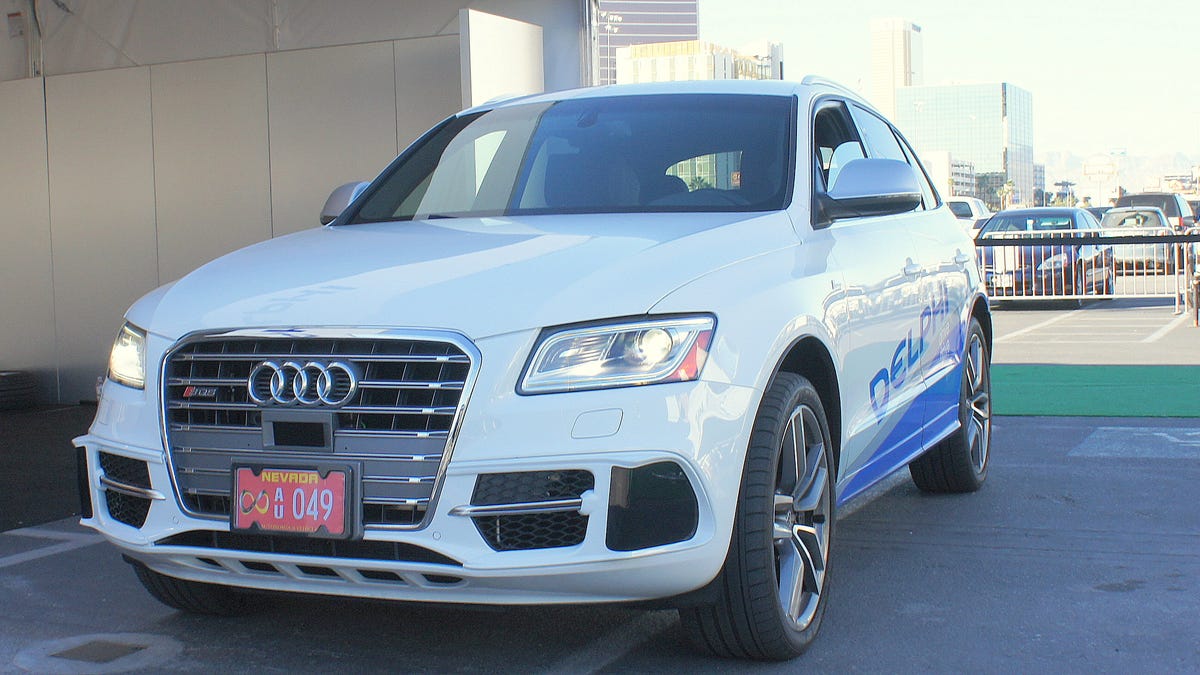Delphi's computer chauffeur drives me around Las Vegas at CES 2015
Automotive supplier Delphi demonstrates its self-driving car platform called Drive on the streets of Las Vegas during CES 2015.

LAS VEGAS -- In Audi's boldest self-driving experiment, it sent its A7 model-based research car from San Francisco to Las Vegas, covering 550 miles. That car piloted itself on highways, but required a human driver to take over when it approached cities and towns. Automotive supplier Delphi showed off its new Drive platform with a self-driving tour on the crowded streets of Las Vegas.
I wasn't quite sure what was in store when John Absmeier, Director of Delphi Labs in Silicon Valley, invited me to get in the front passenger seat of an Audi S Q5. The car features Delphi livery and a few very minor cosmetic differences from a production S Q5. In the cabin, I could see that the center LCD, usually showing navigation, audio and phone information, now displayed a rendered image of the car surrounded by blue lines and a scattering of dots.
A Delphi staffer, certified to "drive" autonomous cars, took the driver's seat and steered the car onto a busy Las Vegas street near the convention center. After a while, he pushed a button and took his hands off the wheel and feet off the pedals. He had previously programmed a waypoint and a destination into the Delphi Drive system, defining a loop for this demonstration.
The car unerringly followed the lane and the speed limit, avoiding collisions with other cars nearby. Coming out from an underpass, the S Q5 came across a line of stopped traffic and had to brake quickly, but handled it all quite well.
More impressive, however, was how the car moved into a left turn lane, automatically turning on its signal, because it had plotted its route to the programmed waypoint. There was a lot of traffic, so only a a few cars got through the left turn light before it went red. We sat at the light until it turned green and more cars went through. As we approached, the light went yellow and the S Q5 refused to go through, stopping safely behind the limit line.
Absmeier told me they had programmed the car conservatively, so that it would not go over the speed limit and would choose to stop at a yellow light rather than try to run it.
At a few other points during the drive, the car stopped at intersections with crosswalks. I could see the crosswalk indicator on the car's LCD, showing its camera had identified the painted lines on the road. More interesting, it showed the crosswalk indicator in green if it was clear, and red if there was a pedestrian. The car appeared more aware than most human drivers, as it had 360-degree sensor data continuously feeding into its "brain."
After observing the car handle these traffic situations, I was not surprised when it safely arrived back at our starting point, the destination programmed into the Delphi Drive system.
Sensor load
Delphi uses this vehicle for its self-driving research, so it features more sensors than a production self-driving car would actually need. Six LIDAR modules, enabling laser scanning of the environment, were mounted discreetly around the body. Six radar modules, the same sort Delphi sells for adaptive cruise-control systems, complemented the laser scanning. A high-resolution camera recorded the view through the windshield, helping the car recognize lane lines, traffic lights and speed limit signs, while a high-definition GPS unit told the car where it was in relation to its stored street map.
In addition, Delphi equipped the S Q5 with a vehicle-to-vehicle (V2V) communication system, similar to what it will supply Cadillac for its production vehicles next year. V2V enhances self-driving by letting cars broadcast crucial driving information to each other, such as when they are braking.
All this sensor data was being processed by Delphi's Multi-Domain Controller, a computer that uses the sensor data to build a virtual environment around the car, then determine how it should react to each situation that arises. For the Multi-Domain Controller, Delphi partners with a company named Ottomatika, which develops self-driving algorithms.
Although the Delphi Drive system showed me how close we are to getting real self-driving cars on the road, this technology will likely roll out a feature at a time. Absmeier explained that Delphi Drive is scalable, in that it can be loaded with specific self-driving modules. As an example, an automaker could enable adaptive cruise control with automated lane changing, but leave out other modules that enable urban autonomous driving. Those limitations could be in response to regulations permitting only limited self-driving features.
However, Absmeier also pointed out that the system allows over-the-air updates, so you could buy a car with the system that only offered a limited range of self-driving features, then at a future date the automaker could push out full self-driving capability.

